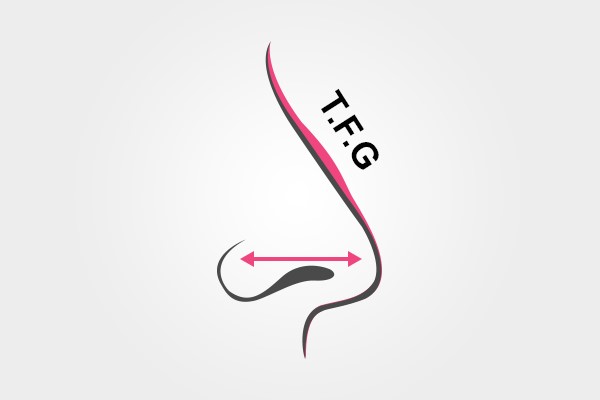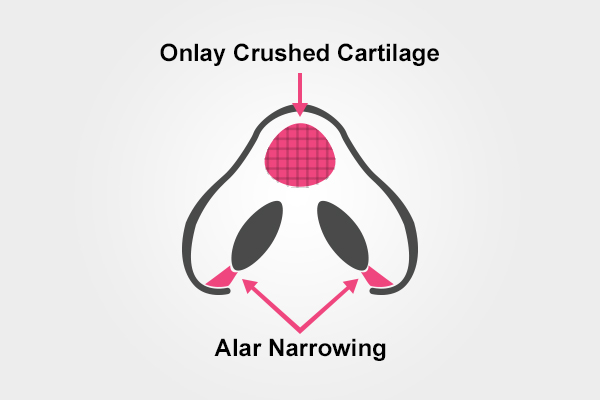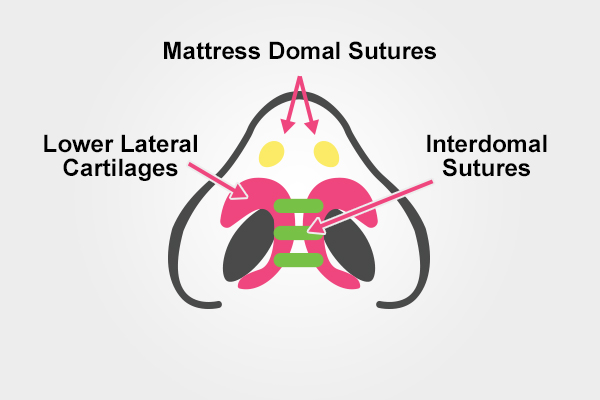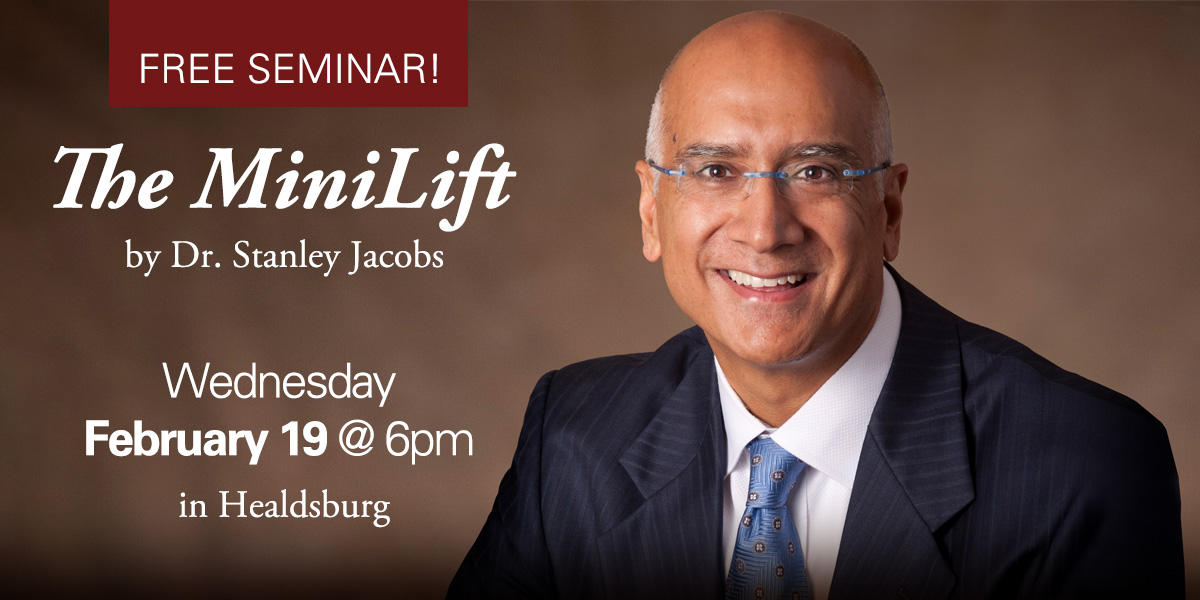Every year, half a million people who are interested in improving the appearance of their noses via rhinoplasty—nose surgery—seek consultation with facial plastic surgeons. People seeking rhinoplasty in the Sonoma County area are no different. Some are unhappy with the noses they were born with and some with the way aging has changed their nose. For others, an injury may have distorted their nose, or the goal may be improved breathing. No matter what their reason, one thing is clear: Nothing has a greater impact on how you look than the size and shape of your nose.
Because the nose is the most defining characteristic of the face, a slight alteration via a nose job can greatly improve one’s appearance.
Rhinoplasty may typically be thought of as a surgery that makes a large nose smaller, but it can more accurately be described as creating a nose that is proportionate with the rest of a person’s unique facial features. Our surgeons may perform a rhinoplasty to adjust a nose’s width, alter the shape of the nostrils, restore symmetry, eliminate a bulge or hump, or employ some combination of these and other procedures.
As with all facial plastic surgery, good health and realistic expectations are prerequisites. Understanding the details of rhinoplasty is also critical. Since there’s no ideal in rhinoplasty, the goal of a nose job is to improve the nose aesthetically, making it harmonize better with other facial features.
Skin type, ethnic background, and age are important factors to be considered in discussions with your surgeon prior to a nose job. Before any alterations are made, a young patient must reach full growth, usually around age 15 or 16. Exceptions for a nose job are made in cases in which breathing is severely impaired, but the general rule for patients is that their face has stopped growing.
Before deciding on a nose job, ask if any additional surgery might be recommended to enhance the appearance of your face. Often, patients also have chin augmentation in conjunction with rhinoplasty to create a better balance of features.
Our surgeons approach each rhinoplasty surgery with a detailed surgical plan tailored to deliver the best outcome for every individual patient. This entails taking into account not only the nasal features that a patient would like altered or refined, but also the effects of that alteration on the rest of the nose. To achieve this, your surgeon creates and follows a detailed nose job plan of action that takes into account the entire nasal structure to ensure that optimum surgical results are delivered to create a proportionate, functional, and aesthetically pleasing nose. The illustrations below are a representative example of a Rhinoplasty Battle Plan for an actual case that was performed by Dr. Jacobs.



Rhinoplasty is one of the most versatile cosmetic surgeries, as it can involve any number of changes. Patients choose a nose job to:
A nose job can include one or many elements. The specifics depend on each patient’s current nose and desires for the future.
Many people choose to get a rhinoplasty for aesthetic reasons, but the surgery can also have a functional benefit. A nose job can include widening narrow airways, straightening a deviated septum, and more to help patients enjoy unobstructed breathing. Making cosmetic repairs to correct improperly aligned nasal features can often help to improve the free flow of air.
Talk to your surgeon about any of your personal cosmetic or physical concerns during your rhinoplasty so the surgery can be approached with a full understanding of what you are hoping the nose job procedure will accomplish aesthetically and functionally.
Whether a patient wants a rhinoplasty for functional or cosmetic reasons, the choice of a qualified facial plastic surgeon is of paramount importance. Many facial plastic surgeons are trained in both ear, nose, and throat (ENT) and facial cosmetic surgery, which provides you, the patient, with the highest level of training and expertise. Dr. Jacobs had an ENT practice for many years before dedicating his plastic surgery practice strictly to facial plastic surgery.
Prior to performing a nose job, your surgeon will examine the structure of your nose, both externally and internally, to evaluate what you can expect from rhinoplasty. He’ll also discuss factors that may influence the outcome of the surgery, such as skin type, ethnic background, age, degree of deformity, and degree of function of nasal structures.
You can expect a thorough explanation of his procedure and the risks involved in a nose job. During your rhinoplasty consultation, your surgeon will take photographs of your nose to create imaging of your potential results and discuss the options available. He’ll explain how the nasal structure, including bone and cartilage, can be sculpted to reshape the nose and indicate how reshaping the chin, for example, could enhance the desired results.
Our team has used computer imaging for decades, allowing us to show patients what their noses could look like after a rhinoplasty procedure. The final results will not exactly match the initial imaging, but the visuals do allow patients to see the doctor’s vision. He believes in bringing his patients into the creative process by using the imaging to slowly reveal changes to their nose while they watch. If they do not like what they see, everyone will be aware of their preferences before the surgery, and the details can be altered to their satisfaction. This ensures that the whole team is on the same page and provides patients with a much better feeling about their proposed surgery. It also allows our surgeons to display their aesthetic skills and demonstrate how to apply them to their unique features.
At your rhinoplasty consultation in our office, the surgeon will review your medical history with you. His staff will discuss the cost for the procedure and work with you to schedule your nose job surgery date in our Healdsburg surgical suite.
Though every rhinoplasty case is unique, there is a general set of steps patients can expect.
A patient will first receive an intravenous sedative. Since rhinoplasty is a surgical procedure, this is necessary to dull sensation in the area for continued comfort.
The actual surgical portion of a rhinoplasty may be either “closed” or “open.” For a closed surgery, your surgeon will make all of the necessary incisions inside the nose itself, essentially hiding them where they can’t be seen. An open rhinoplasty requires an incision on the tissue separating the two nostrils, known as the columella.
The closed nose job method results in a lack of scars outside the nose, but also requires the surgeon to work though a limited opening. The open nose job method allows our surgical team to peel back the skin and expose the bone, cartilage, and other tissue beneath for ease of access. Our team uses the open approach much more than the closed, comparing the two by explaining the difference between fixing your car’s engine with the hood almost down and opening the hood all the way to see everything you need to see.
While the necessary incision for an open rhinoplasty is placed in what is technically a visible area, the doctor makes every effort to ensure that the resulting scar is as unobtrusive as possible. The line is typically very thin and remains unnoticed.
Once the surgeon has gained access, he can perform any number of steps designed to alter the nose, including removing bone or cartilage as necessary, adding grafts, straightening any deviation in the septum, and more. Remember, the end goal of rhinoplasty is a proportionate face with a nose that does not obviously stand out or seem out of balance with the rest of the surrounding features.
After the nasal structure and tissues are adjusted, any sutures needed will be put into place. In the case of an open rhinoplasty, the skin will be redraped and secured.
Immediately after nose surgery, your surgeon will place a small splint on your nose to protect it and to keep the structure stable for at least five to eight days. Your face may feel puffy, especially the first day after rhinoplasty. Pain medication may be required.
You will need to keep your head elevated as you rest and sleep to keep swelling and bruising as minimal as possible.
For the best nose job results, it is important that you follow our team’s post-surgical directions. Sun exposure, exertion, and risk of injury must be avoided. If you wear glasses, special arrangements must be made to ensure that they don’t rest on the bridge of your nose. Follow-up care is vital after a rhinoplasty to monitor healing. You should immediately report anything unusual to your surgeon and keep your follow-up appointments. Typically, insurance does not generally cover cosmetic surgery procedures. Nose surgery to correct or improve nasal function or surgery for major deformity or injury may be reimbursable in whole or in part, but it is your responsibility to take care of this.
Post-surgical swelling typically resolves in a matter of weeks, though more swelling may ebb and flow in the following months. Patients may find that their new nose will continue to subtly change throughout the year after their rhinoplasty, ultimately settling into the permanent shape and size intended by the surgery. It is important to remember that a patient’s individual anatomy and healing processes help to determine the final outcome of a nose job.
Since rhinoplasty has so many potential variations that depend on a patient’s unique anatomy and goals, the best way to determine cost is to get an assessment of the surgery’s projected scope from our surgeons during a consultation, and then work from there.
As mentioned above, some patients use their rhinoplasty as an opportunity to better balance their facial features overall. A chin enhancement can add to a stronger profile, while ear surgery can reduce the prominence of overly large or visible ears. Our surgeons uses their unique talents, experience, and focus on faces to approach patients’ needs not as isolated surgeries and procedures, but as alterations made to produce a harmonious whole.
Note that although a rhinoplasty impacts the shape and size of the nose, a nose job does not improve skin tone or appearance. Patients who want to rejuvenate their skin after healing sufficiently can enjoy a chemical peel to reduce the appearance of sun damage and acne scars. Dermal fillers are available to fill in laugh lines between your nose and your mouth, as well as other wrinkles and hollows that can appear on the face.
During your nose job consultation, you can talk to the doctor about the range of options available to you.




by Dr. Stanley Jacobs
Feb 19 @ 6pm in Healdsburg
Learn more about the MiniLift and whether you would be a candidate for this exciting procedure.
